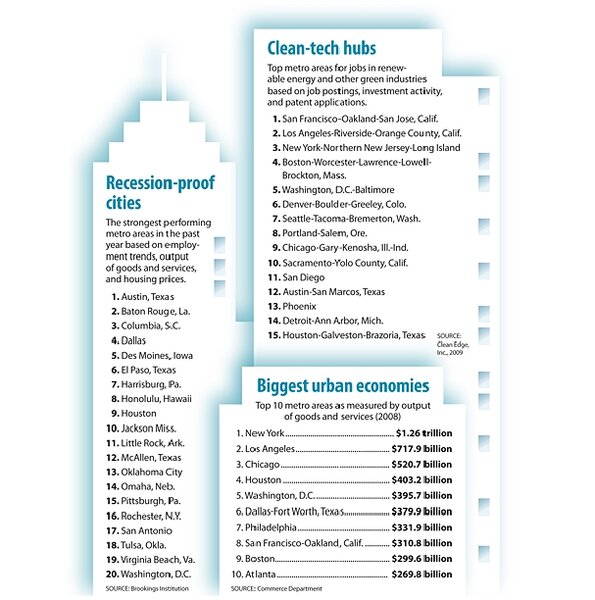Five cities that will rise in the New Economy
Loading...
| Fort Collins, Colo.
In Houston, the Texas Medical Center is expanding so quickly that it will soon become the seventh largest downtown in the US. By itself. The hospital complex brims with restaurants, shops, and hotels, and employs 100,000 people – the population of Billings, Mont.
In Seattle, the erector-set cranes along the waterfront and big forklifts at the airport are loading exports into containers with the constancy of a piston: plywood to Beijing, halibut and crab to Tokyo, Granny Smith apples to Moscow. Last year, Washington was the only state to ship more goods to China than it receives.
In Fort Collins, Colo., town fathers are aggressively transforming the heart of the city into a zone that generates as much electricity as it consumes – making it a showcase for the city’s quest to become the Silicon Valley of clean energy.
As the United States emerges from the worst recession in 80 years, a new economy is taking root that will help create the next tier of powerhouse cities in America. Just as the Industrial Revolution of the late 1800s and the Information Age of the past 40 years helped shift the urban and regional balance of power in the US, forces are now at work that will shape who prospers in the economy of tomorrow.
No one yet knows the exact contours of the New Economy. It is more Monet than Rembrandt. But experts say that certain characteristics are already visible on the canvas that will give cities advantages in attracting new jobs and industries.
“In a broad sense, we are at an inflection point,” says Mark Muro, policy director at the Brookings Institution’s Metropolitan Policy Program. “We are looking at the outlines of a new economy where we consume less, save more, increase our exports, and need to become greener.”
Start with something as prosaic as foreign trade. The permanent trend toward a global economy and the more ephemeral one of a weak dollar are uniting to make places with shipping ports and international airports the rail spurs of tomorrow. That’s why a small firm like the Vaughn Company, located southwest of Seattle, can blossom into a business of 80 employees by selling its unique “chopper pumps” for wastewater treatment to customers in more than 70 countries.
Nor is logging more orders abroad the only advantage. Some companies in Europe are finding the euro so strong compared with the dollar that it makes more sense for them to set up plants in the US rather than ferry their goods here. Thus a French manufacturing giant, Alstom, is opening a turbine plant in Chattanooga, Tenn., where it will employ 360 people. It will ship its machinery, destined for nuclear plants, by a method as old as Huck Finn – down the Tennessee River by barge.
According to a Brookings Institution analysis, other inland cities are boosting their trade with foreign nations as well – including Augusta, Ga.; Wichita, Kan.; and Rochester, N.Y.; especially with the fast-growing BRIC countries (Brazil, Russia, India, and China).
In the approaching “creativity economy,” as some are calling it, education will be more vital than ever. This means not just an educated workforce but universities that are interwoven with their communities.
The ivory tower is no longer the model. Now it’s being replaced with universities that turn out corporate spinoffs as well as graduates. Cities such as Huntsville, Ala., – which has a greater concentration of PhDs than it does Baptist churches – are becoming factories for the most important product of tomorrow: ideas.
In other areas, healthcare complexes are evolving into microeconomies in themselves. They attract labs and researchers. Patients fly in from around the world, needing hotel rooms, and laundry and banking services. The University of Pittsburgh Medical Center annually pays out $2.7 billion in salaries to its 50,000 employees – the equivalent of the entire Canadian aerospace industry.
Every city, meanwhile, is pining to become the next clean-technology hub. Makers of solar panels, battery-powered cars, and green building materials are to the 2000s what biotech firms were to the 1980s. Certainly, not every city will succeed in becoming the next “Solarcon Valley.” But urban areas both large and small are occupying territory in the green revolution – Vandergrift, Pa., as a fabricator of energy-efficient windows; Toledo, Ohio, as a seat of solar energy; San Diego as a hub of biofuels.
The result of all this may be a shuffling of economic power not just among cities but regionally. During the low-cost energy years, the South and Southwest boomed. Nonunion labor was more important than a college degree. “Now, it might be New England and the coastal areas that lead us more than the South and the Sun Belt,” says Mr. Muro.
Demographics will drive change, too. Cities that have expensive housing may find themselves at a disadvantage in attracting young people. “We’re going to be facing what I call the third civil war – it’s going to be a war between cities and metro areas over where young people will settle, because we’re going to have to fill a lot of jobs,” says Barry Bluestone, an economist at Northeastern University in Boston.
Many of these young workers will be going to places where they sense a think-outside-the-box culture. “It’s hard to be a dynamic economy if you’re a culture that does not tolerate risk,” says Susannah Malarkey, who heads a trade group, the Technology Alliance, in Seattle.
Cities, of course, have been reinventing themselves since the days of cobblestone streets. Pittsburgh went from being the nation’s Bessemer furnace to an education and medical technology leader. Boston, once a textile hub, is the cerebrum of America with all its colleges. What will be the next power centers?
Any list is a bit arbitrary. But below are some cities that at least show the forces remaking urban America, hastened by the rasp of recession. “The collapse two years ago was so dramatic, so unexpected,” says Barry Mason, dean of the business school at the University of Alabama. “But out of crisis comes opportunity.”
1. Boston is magnet for high-skilled workers
2. Fort Collins, Colo., builds on clean tech
3. Houston aims to move beyond the oil age
4. Huntsville eyes next launchpad for growth
5. A Seattle slew of advantages
6. The next boom cities overseas
____________
-- Look for us on Twitter.






